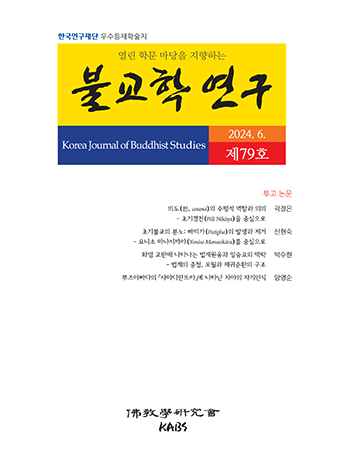Abstract
References
Sorry, not available.
Click the PDF button.
Information
Geumgangam Hermitage in Boryeong enshrines a stone seated Buddha statue in the Mireukjeon (Hall of Maitreya Buddha). And along with the statue, a stone monument that gives a clue to the background of this temple’s foundation has handed down even though its bottom has been broken and lost. According to the memorial stone, Geumgangam was founded as a private temple for Royal Concubine Gwon under the responsibility of Venerable Yeongam who belongs to the genealogy of King’s Teacher Muhak. The Maitreya statue was created in winter, 1412 and sponsored by Gwon Hong, Mayor of Hanyang (capital of Joseon Dynasty, present Seoul), and his wife Princess Lee for their daughter Royal Concubine Gwon. Considering their situations, two motives of the creation of the statue can be suggested; first, for the conception of a son and second, for the investiture of Royal Concubine Gwon. Gwon Hong had some relationships with Ming’s imperial family, so it was thought that the Buddhist circle tried to use the influence of Ming to cope with the policy of suppressing Buddhism during the Dynasty Geumgangam stone Maitreya Buddha has unique characteristics in shape. Conspicuous of those are the okgaeseok (roof of stone stupa)-style canopy on his head and Younghwain mudra that is holding Yonghwa before the chest. The canopy is round and has six ridges on it, which makes it the one and single example of its kind. Also, the groove in the middle of each ridge shows the trace of dragon head-shaped ornaments that can be seen at the roof of stupa of Bogakguksa in Cheongyongsa site and that of stupa of Venerable Muhak. In conclusion, the stone Maitreya statue in Geumgangam is not only the single stone Buddha statue from early Joseon Period but also the earliest among extant statues from that period. Furthermore, with written record about the background and year of creation, it provides valuable sources for the study of Buddhist sculptors in early Joseon Period.
보령 금강암 미륵전에는 석조미륵불좌상이 1구 있고 절 창건과 조성배경에 단서가 적혀있는 비편이 전해져 오고 있다. 불상의 형식을 통해 얼굴이 크고 어깨가 좁은 세장한 신체, 좁은 무릎, 대좌 중대가 낮고 하대와 중대가 일석으로 치석한 점 등 전체적으로 고려후기의 영향력이 많이 남아있음을 확인하였다. 금강암 석불의 특징으로는 용화인과 천개의 착용이다. 용화인은 용화를 쥐거나 들고 있는 수인으로 인도 굽타시기부터 등장하여 중국을 거쳐 우리나라 삼국시대 불상부터 나타난다. 고려후기 용화인 불상의 영향을 받은 금강암석불은 서울 약사사석불과 안성죽리 불상으로 이어졌다. 금강암석불은 마루가 표현된 옥개석형 천개를 착용하고 있는데 마루가 6개이고 원형인 유일한 작례이다. 이런 형태는 청용사지 보각국사 탑 옥개석과 무학대사 승탑 옥개석에 등장하는 용두장식 때문임을 확인하였다. 이러한 용두장식은 조선초기 왕실과 관련한 승려의 탑에서만 등장하므로 금강암 석불이 왕실발원 불상이기에 이러한 장식이 나타날 수 있었음을 제시하였다. 비편에 따라 금강암은 왕사 무학의 문도인 영암비구가 불사를 책임지어 궁주권씨의 원당으로 창건되었고 불상조성은 미륵불로 1412년 겨울에 이뤄졌으며 주관자는 판한성부사 권홍(權弘)과 옹주이씨라 알려졌다. 본 논문에서는 보다 자세한 창건과 불상조성 발원 내용을 당시 권홍과 궁주 권씨가 처한 상황을 유추하여 첫째 득남, 둘째 빈 책봉 이었을 가능성을 제시하였다. 또 당시 태종대 불교억압책에 맞서 불교계의 대응의 한 방법으로 명 황실을 통해 불교억압책을 약화시킬 수 있다는 인식이 있었으므로 안동 권씨를 활용하고자 하는 당시 불교계의 주류인 무학계 의도가 반영되었을 가능성을 제시하였다. 결론적으로 금강암 석불좌상은 조선전기 현재 실물이 남아있는 왕실발원 불상 중 시대가 가장 빠르고 석불로는 유일한 불상이며 조성배경과 제작시기가 확인된 기년명 불상으로 조선전기 불교조각사에 매우 중요한 불상임을 확인하였다.
Click the PDF button.
- Publisher :Korean Association of Buddhist Studies
- Publisher(Ko) :불교학연구회
- Journal Title :Korea Journal of Buddhist Studies
- Journal Title(Ko) :불교학연구
- Volume : 53
- No :0
- Pages :53~81


 Korea Journal of Buddhist Studies
Korea Journal of Buddhist Studies






